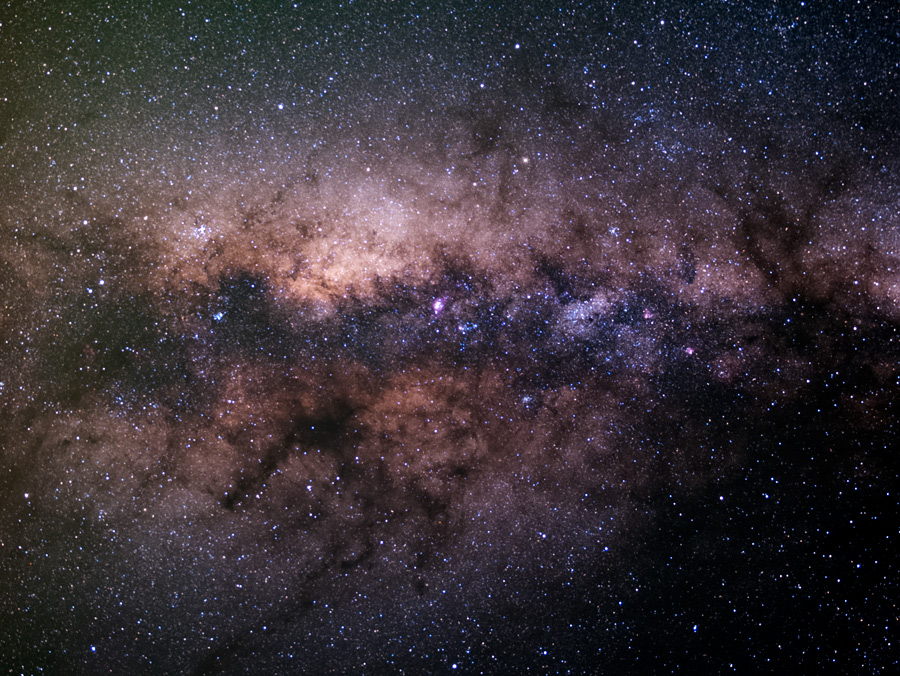Astro Imaging
For imaging the night sky, I use a Nikon D700 DSLR camera connected to a Celestron CPC 1100 Telescope. When using a Hyperstar accessory, the telescope essentially becomes a 560mm f2.0 lens when paired with the Nikon camera. Optionally, the telescope can function as a 2800mm f10 lens. A reducer gives a middle of the road ~1600mm at f6.3. Finally, sometimes I piggy back the camera with a Nikon Lens on top of the telescope.
The moon was aquired as a single fast exposure. The galaxies and nebula below were captured by combining anywhere from 20 - 150 images (typically 30 seconds exposure each), and stacking them, increasing signal to noise ratio on these dimmer objects.
For other planetary imaging, such as Jupiter, I use a small webcam and image for about one minute, generating about 1800 frames (at 30 FPS). Using Registax, these images are sorted for quality, and the top few hundred are kept and integrated into a final result. This approach has allowed amateur astronomers to capture planets at a level of detail that until recently has only been possible with large scientific observatories.
Two images, "Thor's Helmet" and NGC 925 were captured as part of a telescope program at Arizona's SkyCenter, with assistance of Adam Block. Click here for a summary of this trip.

M45 - The Pleaides (Seven Sisters) - 435 Light Years away.

Milky Way Center, taken with a Nikon D700 and a 24-70 f2.8 lens from the dark skies over Greer, Arizona.

M13, a Globular Cluster of a few hundred thousand stars.

NGC 2024 - Close up of Horsehead Nebula.

M31 - Andromeda Galaxy - 2.5 million light years away.

NGC 925, imaged with assistance of Adam Block at Arizona SkyCenter.
Click here for a summary on this capture.

Thor's Helmet, imaged with assistance of Adam Block at Arizona SkyCenter.
Click here for a summary on this capture.

M33 - The Triangulum Galaxy - 2.4 million light years away.

NGC 891 - An edge on spiral galaxy about 30 million light years distant.

NGC 891 - Closer up - This image made from 100 x 30 second exposures at f6.3 / ISO 25,600 on Nikon D700.

Interacting Galaxies M81 (left) and M82 (right).
M81 is believed to have a massive black hole in its center.

M51 - Whirlpool Galaxy and a companion galaxy on the left (NGC 5195).
These two interacting galaxies are estimated to be around 23 million light years away.
100 images x 30 seconds at ISO 12,800 on Nikon D700 with CPC 1100 and f6.3 focal reducer.

M101 - Pinwheel Galaxy, with a mass of around 100 billion suns. Top image assembled with
119 images x 30 seconds at ISO 25,600 on Nikon D700 with CPC 1100 and f6.3 focal reducer.
Bottom image with supernova using 40 images x 30 seconds as ISO 6400, D700, CPC1100 + f6.3 reducer.

Sombrero Galaxy, taken with D700 and f6.3 focal reducer on CPC-1100 Telescope

M27 planetary nebula, taken with D700 and f6.3 focal reducer on CPC-1100 Telescope.
About 1,360 light years away, expanding at 31km/sec.

Running Man nebula (NGC 1977).
This image made using a D700 at 30 seconds, 65 exposures at ISO 6400 on 12/26/11.

M42 - The Great Orion Nebula (bottom) and NGC 1977 - The Running Man Nebula (top left).

The moon Io can be seen casting its shadow on Jupiter. Farther left, moon Callisto.

Saturn, taken with a webcam attached to the telescope on April 24, 2011.

Venus transit, June 5, 2012. Venus can be seen as the small dot on the top right.
Taken with a Nikon D800 with 80-200f2.8 VRII lens + 1.4TC + Solar Filter

Venus transit, June 5, 2012. A close up of Venus taken with CPC-1100 Telescope paired with a Webcam.

Solar Eclipse, May 20, 2012. Near Tucson, the moon covered most of the Sun around 7:00 PM local time.

Moon, taken with Nikon D700 plugged into the telescope.

Lunar Eclipse, as the Earth's shadow darkens the moon, taken December 21, 2010.
The red tint is due to blue light absorption by the Earth's atmosphere.

Moon, amplifying existing colors as captured by my camera reveals
existing subtle hues.

Milky Way rises over Hanalei Bay, Kauai.
© 2020 John Miranda